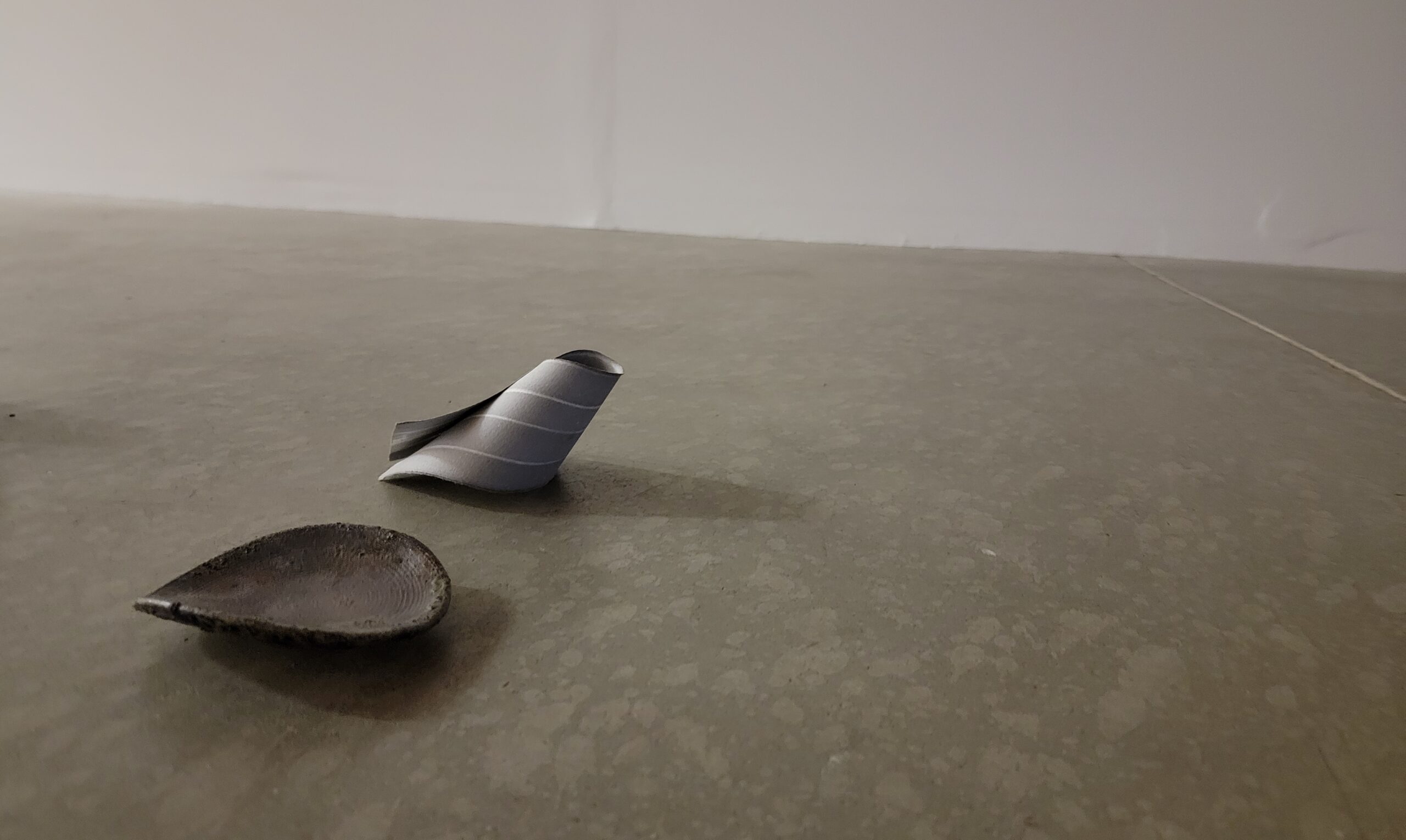キュレーターで元益子陶芸美術館学芸員の川北裕子さんが、エッセイを寄せてくださった。私が轆轤を挽くきっかけとなったのは、川北さんが企画された加守田章二展を体験し、彼女のやきものに対する視線と思考に触れたことが大きい。(空間を生成するような線をひいてみたい)と思わされた。この「Room 間」を開くにあたり、『川北さんが今お考えのことを自由に書いてください』とお願いした。深謝いたします。Yuko Kawakita, a curator (formerly at the Mashiko Museum of Ceramic Art), kindly contributed an essay. My throwing a wheel was largely triggered by an opportunity to experience her curated exhibition on Kamoda Shōji and to be exposed to her way of thinking/seeing ceramic art. I felt, “I’d like to draw/throw a line that could engender space”. For opening this Room 間, I asked her “please write freely what are in your thoughts”. With a deep bow. (English Translation follows the original Japanese text.)
進藤詩子における陶と土
川北裕子
進藤詩子と出会ったのは2021年春、益子陶芸美術館で開催した「加守田章二 天極をさす」展の時であった。加守田章二(1933〜1983)は20世紀後半の陶芸界に彗星のごとく現れ、たった20数年間という短い制作期間を駆け抜けていった作家である。にもかかわらず、「20世紀の陶芸は加守田章二を得て幸福だった」といわれるくらい、加守田のこの分野への貢献は計り知れない。口縁のシャープな造り、高温で焼成しながらも土器を彷彿とさせる湿潤で柔らかな土の表情など、彼が陶の現代にもたらした美質とマチエールは、陶芸を深く知る人にも、また陶芸の鑑賞に馴染みのない人にも、今なお鮮烈な印象を与える。土という素材が持つ重力を受け止めながらも時としてそこに拮抗しようとする願望も顕わにした加守田は、絶えず何かを乗り越えようとしていた。素材がデザインを規定すると考え、手垢のついていない土を求めて、制作地も作風も立ち止まることなく変え続けた。作品が器形であることは加守田章二の制作の核心であり、常にそこから脱却していこうとする契機を孕むものでもあった。うつわの形態を以て、言語化しがたい陶の本質を翻訳しようとしていた、ともいえるのだろうか。ただ、彼がこの世界に残したギフトの意味を、私たちはまだ必ずしも、十全には読み解くことができていない。
かねてから土による表現に興味を持っていた進藤は、益子で得たインスピレーションを手繰るように、当時住まいを構えていた東京・八王子の土を用いて轆轤をひき、うつわを創り出した。その仕上がりは、初めてやきものに取り組んだとは思えないほど上出来だが、工芸としての完成度は、進藤の求める土で制作することの意味とはあまりかかわりがないのかもしれないし、上達していくこととは別次元の創作を慎重に見届けてゆきたい。
陶に抽象表現を見出す態度はアグネス・マーティンにもみられ、進藤もまた、陶やうつわが有する抽象性を深く意識していると思われる。特に轆轤の回転運動による成形は、粘土に手を添えるだけでうつわが立ち上がるという性質上、作者が試行錯誤をしながら構築していく手びねりとは異なり、身体の反復的な動作がそのまま抽象表現へと昇華する側面がある。思考を無にし、轆轤で土に触れることの純粋な愉悦は、即物的な現実世界の回路を忘却させ、観念的な思索へと飛躍することもある。時折、うつわの小宇宙から崇高さを引き出す作家が登場するのはこうした理由もあるのだろう。例えば黒田泰蔵(1946~2021)は、轆轤成形の営みに、給仕時代の皿洗いの作業から、個を超越した宇宙との一体を説く精神論までを紐づけ、聖と俗を往還しながらその作業の真理を見出そうとした。
陶は土から生まれるが、決して土に還らない。あくまで土から陶へという一方向の物理的な変換である。作り手の記憶が陶になるとき、元来は形態のなかった土が収縮し、ひびや割れ、裂け目といった要素が顕わになり、新たな美的経験を生むものとなる。土から陶になるプロセスにおける所与の条件が、造形を規定していく。一方で、研究と制作、平面と立体、居場所の変遷など、複数の軸を据えながらその間行き来する運動体としての進藤にとって、土はどれほどネイティヴな言語でありうるのだろうか。それとも、進藤にとって土は、第二、第三言語なのだろうか。土は太古の記憶を孕む包容力のある素材であり、また対峙する者を圧倒する力も持っている。素材やアプローチに対する相対的な態度でどこまで土を自らの母語とすることができるのかは未知数だが、ドローイングに意味を見出し、異素材を往還できる進藤だからこそ、土から陶へ「何が」変換されているのかを見出すことができる可能性もある。さらに言えば、大抵のうつわはそれ自体では乾いており、潤いを補うことで完成するようにできている。空虚であるがゆえに、他者とのかかわりの中で何かを受け容れ、満たすことができるのがうつわの本質でもある。そこに、言葉と言葉の行間のような、目には見えないけれども確かに必要な「間」が存在するのである。 おそらく作家はそのことを直観しており、進藤の陶と土への向き合いから、この分野にどのような翻訳の可能性がもたらされるのか、楽しみである。
Clay and Ceramics in Utako Shindo’s Art
I first met Utako Shindo in the spring of 2021 at the exhibition “Kamoda Shōji : Gravity and Flight” held at the Mashiko Museum of Ceramic Art. Shōji Kamoda (1933-1983) was a ceramic artist who suddenly emerged like a shooting star in the world of Japanese ceramic art in the second half of the 20th century but only spent twenty-odd years as a ceramic artist. Nevertheless, his contribution to the field was immense. It is often said, “The great fortune of twentieth-century Japanese ceramic art was having Shōji Kamoda.” The sharp feel of the rim, and the soft, moist texture of the clay, despite being heated at high temperatures, resembles that of earthenware. These aesthetic qualities and textures he brought to the modern ceramic art world still make a vivid impression on both connoisseurs of pottery and those who are less familiar with it. Kamoda continuously tried to expand the possibility of expression by accepting the gravity of the clay but at times showing defiance against it. Based on his belief that the material used defines the design, he constantly moved to different locations in search of clay that would show his originality and his style of work changed accordingly. The essence of his work lies in the shape of his vessels, which also implies his urge to transcend these. It can be said that he used the form of vessels to render the impalpable nature of ceramics into visible terms. However, we have not yet fully interpreted the significance of his gifts.
Shindo, who was interested in using clay, worked on this material from Hachiōji in Tokyo, her place of residence at the time, and created pieces with a potter’s wheel based on inspiration received from her visit to Mashiko, the renowned pottery town. The results were so good that it’s hard to believe this was the first time she had worked in pottery. Yet, I suspect achieving perfection in craftsmanship has nothing to do with what it means to work with clay for the artist and her motivation probably lies elsewhere. I’d like to meiculously study her creativity which has evolved beyond the discipline of mastering technique.
Agnes Martin saw abstract expression in ceramic art and Shindo also shares a deep awareness of the abstract nature of ceramics and vessels. Especially, a rotating potter’s wheel, unlike hand-forming methods which reflect the makers’ trial-and-error process, enables the forming of a bowl shape merely by placing your hand onto the clay and the potters’ repetitive body movements are thus directly sublimated into abstract expression. The sheer pleasure of making your mind blank and touching the clay on the potter’s wheel can divert us from the physical world of reality and plunge us into abstract contemplation. This is probably one of the reasons why some artists find a sublime quality in the microcosm of vessels and aspire to realise that. For example, for Taizo Kuroda (1946-2021) the creative process using a potter’s wheel embodied the key to many aspects of life; from dish-washing jobs he used to have, to his belief in the importance of transcending the individual and becoming one with the universe. By moving back and forth between the sacred and the secular, he tried to find how to define the process.
Ceramics are made from earth but never return to the earth. The physical transformation is always one-way, from earth to ceramics. When ceramics are created from the imagination of artists, the clay which is essentially formless material contracts, bringing cracks, splits and fissures. And these elements define new aesthetic experiences. The conditions inherent in the process of transforming the clay to ceramic determine the design. Meanwhile, Shindo’s work as an artist has evolved between multiple focuses and disciplines including both research and creation, two-dimensional and three-dimensional works, and frequent change of locales. Will she become a fluent speaker of the language of clay? Or will it remain her second or third language? Clay is a receptive material infused with ancient memories. It also has the power to overwhelm those who stand in front of it. With her versatile attitude towards materials and methods, how well she can master the language of clay and make it her mother tongue remains to be seen. Yet her wide interest ranging from drawings to other different materials retains much potential. She should be able to to conceive what will be born out of the transition of clay to ceramic. Moreover, most vessels are dry and completed when moisture is added. The essence of the vessel resides in its emptiness. In relating to others, the void accepts something and becomes fulfilled. There exists a space in-between, invisible and indispensable space which resembles the gap between lines of written text. Probably the artist intuitively knows this. It will be interesting to see how Shindo’s approach to ceramics and clay offers translational effects between different disciplines and thus provides the niche for this art.
Yuko Kawakita
Curator, Formerly at the Mashiko Museum of Ceramic Art
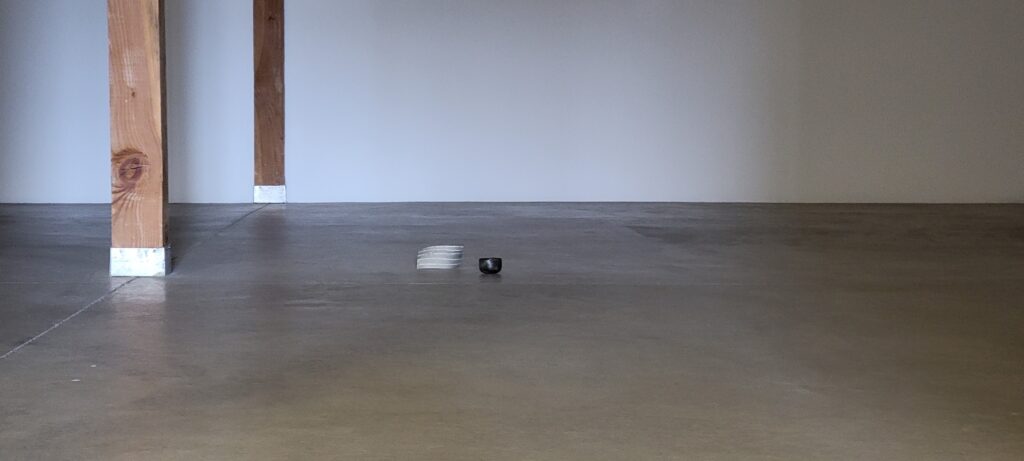
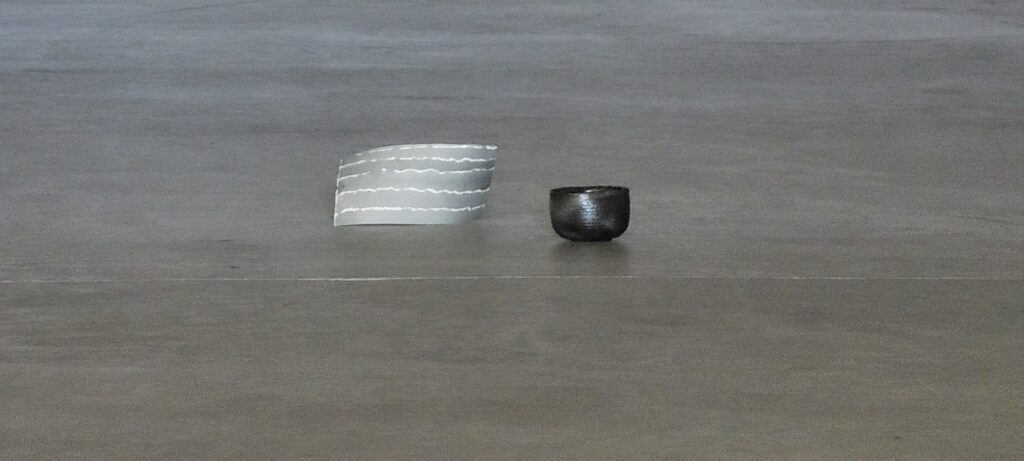
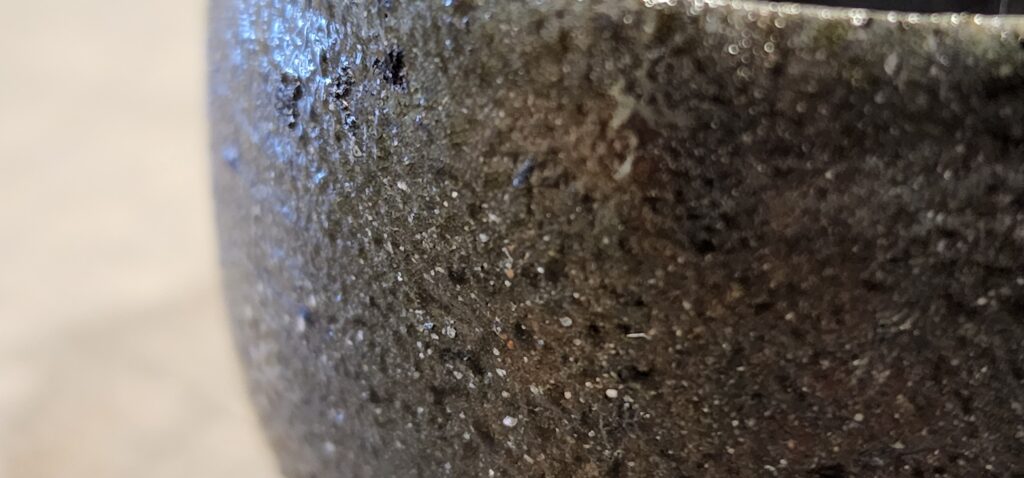
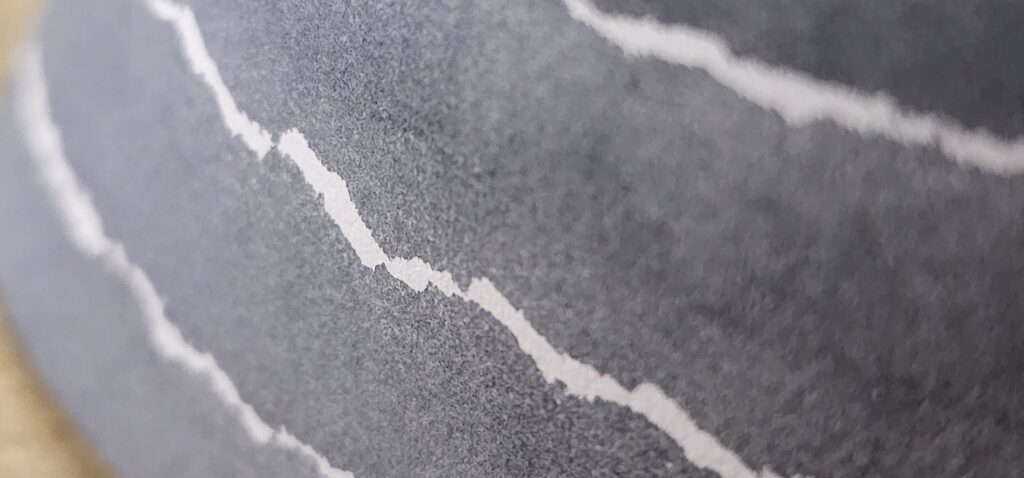
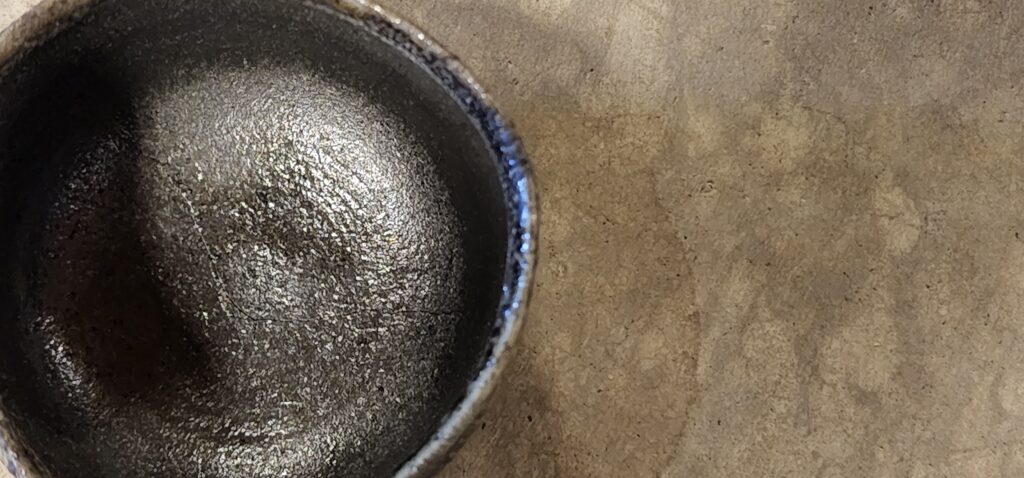
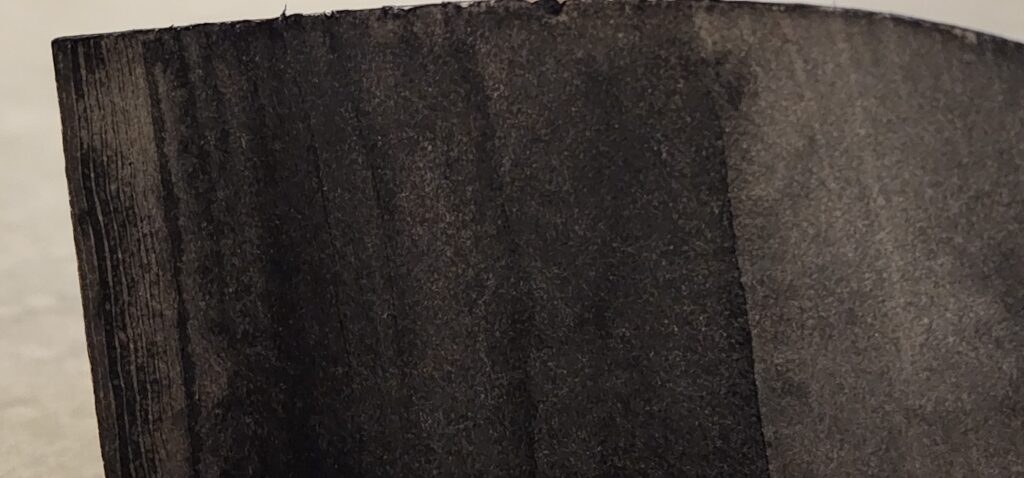
[Utako Shindo, Untranslatable, stoneware vessel/2.5 (diameter) x 1.5 (height) inches, Sumi ink on watercolor paper curved /2.5 x 5.5 x 1.875 inches, 2022]
(photos by Max Baseman)
